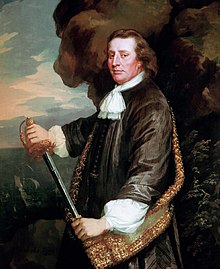It is probable that in the early 1660s Morgan was active with a group of privateers led by Sir Christopher Myngs attacking Spanish cities and settlements in the Caribbean and Central America. In 1663 it is likely that Morgan captained one of the ships in Myngs' fleet, and took part in the attack on Santiago de Cuba and the Sack of Campeche on the Yucatán Peninsula.[5][10][11][n 5]
Sir Thomas Modyford had been appointed the Governor of Jamaica in February 1664 with instructions to limit the activities of the privateers; he made a proclamation against their activities on 11 June 1664, but economic practicalities led to him reversing the policy by the end of the month.[13] About 1,500 privateers used Jamaica as a base for their activity and brought significant revenue to the island. As the planting community of 5,000 was still new and developing, the revenue from the privateers was needed to avoid economic collapse.[13]A privateer was granted a letter of marque which gave him a licence to attack and seize vessels, normally of a specific country, or with conditions attached. A portion of all spoils obtained by the privateers was given to the sovereign or the issuing ambassador.[7]
In August 1665 Morgan, along with fellow captains John Morris and Jacob Fackman, returned to Port Royal with a large cargo of valuables. Modyford was impressed enough with the spoils to report back to the government that "Central America was the properest [sic] place for an attack on the Spanish Indies".[2][14] Morgan's activities over the following two years are not documented, but in early 1666 he was married in Port Royal to his cousin, Mary Morgan, the daughter of Edward, the island's Deputy Governor; the marriage gave Henry access to the upper levels of Jamaican society. The couple had no children.[15]
Hostilities between the English and Dutch in 1664 led to a change in government policy: colonial governors were now authorised to issue letters of marque against the Dutch.[n 6] Many of the privateers, including Morgan, did not take up the letters, although an expedition to conquer the Dutch island of Sint Eustatius led to the death of Morgan's father-in-law, who was leading a 600-man force.[17]
Sources differ about Morgan's activities in 1666.[18] H. R. Allen, in his biography of Morgan, considers the privateer was the second-in-command to Captain Edward Mansvelt. Mansvelt had been issued a letter of marque for the invasion of Curaçao, although he did not attack Willemstad, the main city, either after he decided that it was too well-defended or that there was insufficient plunder.[19][20][n 7] Alternatively, Jan Rogoziński and Stephan Talty, in their histories of Morgan and piracy, record that during the year, Morgan oversaw the Port Royal militia and the defence of Jamaica; Fort Charles at Port Royal was partly constructed under his leadership.[21][22][n 8] It was around this time that Morgan purchased his first plantation on Jamaica.[23]



No comments:
Post a Comment